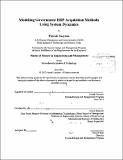| dc.contributor.advisor | Stuart Madnick. | en_US |
| dc.contributor.author | Tazyeen, Farrah | en_US |
| dc.contributor.other | Massachusetts Institute of Technology. Engineering Systems Division. | en_US |
| dc.date.accessioned | 2013-07-10T14:52:50Z | |
| dc.date.available | 2013-07-10T14:52:50Z | |
| dc.date.copyright | 2012 | en_US |
| dc.date.issued | 2012 | en_US |
| dc.identifier.uri | http://hdl.handle.net/1721.1/79536 | |
| dc.description | Thesis (S.M.)--Massachusetts Institute of Technology, Engineering Systems Division, 2012. | en_US |
| dc.description | Cataloged from PDF version of thesis. | en_US |
| dc.description | Includes bibliographical references (p. 104-107). | en_US |
| dc.description.abstract | A large percentage of companies implementing ERP experience schedule and budget overruns. In the two Air Force ERP projects studied in this thesis, DoD has experienced a schedule slippage of 3-4 years and life-cycle cost estimates almost doubled in each of these projects. Given the scale and complexity of these projects, and the number of different stakeholders involved, evaluation of the delay by checking off the high-level critical success factors as per literature does no good. Misaligned incentives between stakeholders especially sponsor organization and system integrator, failure to accommodate rework in the master project plan, choosing the right contract terms, lack of in-house technical expertise, control of sponsor over project execution were some of the aspects which emerged to be important during the case study analysis; and were re-validated using the system dynamics model. The impact of the different contract models on the Critical Success Factors, depending on the level of knowledge on legacy and the completeness of requirements, has also been examined. A System Dynamics model is developed to help in evaluating Lead System Integrator v/s Project management in-house governance models. We consider factors such as the sponsor's ability to adjust the RICE component estimations and the credibility of the contractor-staff working on the project. This thesis sets an outline for importance of governance models and delving deeper onto the process of selecting a contractor and setting incentives which help align the goals of the contractor to those of the sponsor organization. | en_US |
| dc.description.statementofresponsibility | by Farrah Tazyeen. | en_US |
| dc.format.extent | 107 p. | en_US |
| dc.language.iso | eng | en_US |
| dc.publisher | Massachusetts Institute of Technology | en_US |
| dc.rights | M.I.T. theses are protected by
copyright. They may be viewed from this source for any purpose, but
reproduction or distribution in any format is prohibited without written
permission. See provided URL for inquiries about permission. | en_US |
| dc.rights.uri | http://dspace.mit.edu/handle/1721.1/7582 | en_US |
| dc.subject | Engineering Systems Division. | en_US |
| dc.title | Modeling government ERP acquisition methods using system dynamics | en_US |
| dc.title.alternative | Modeling government enterprise resource planning acquisition methods using system dynamics | en_US |
| dc.type | Thesis | en_US |
| dc.description.degree | S.M. | en_US |
| dc.contributor.department | Massachusetts Institute of Technology. Engineering Systems Division | |
| dc.identifier.oclc | 849906690 | en_US |
